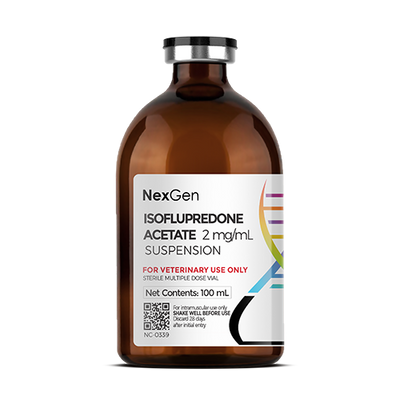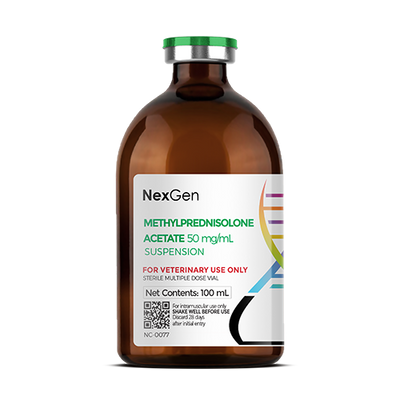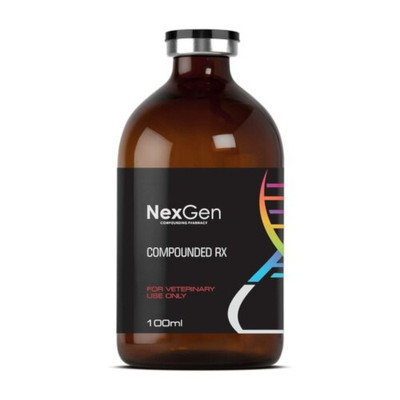
Estrone 10 mg/mL, Injectable Suspension, 100mL
Login for pricing
- Brand
- NexGen
- SKU:
- NC-0033
- Product Type:
- Injectable
- Size:
- 100ml
- Administration:
- Intramuscular
- Availability:
- Currently Unavailable
The determination of whether or not a mare is in foal is based on normal physiological events that occur during her pregnancy. There are a variety of techniques available to help veterinarians tell if a mare is pregnant, all of which have limitations associated with them and may give rise to either false positive or false negative results. Mares have been known to be notoriously irregular in their cycling, making the early determination of pregnancy difficult. Horse owners and breeding operations spend extraordinarily large amounts of money and time in breeding mares; thus, veterinarians and researchers are continually searching for newer and more reliable methods of diagnosing pregnancy.
Signs of Pregnancy in the Mare
The first internal sign of pregnancy in the mare is an increase in uterine and cervical tone, beginning as early as 14 days; at 21 days, this can be reliably determined. The earliest juncture at which a definitive diagnosis of pregnancy can be made by rectal palpation is between 30 to 35 days, when the ventral bulge of the fetoplacental unit (FPU) can be felt at the site of implantation.1 At 50 days, the FPU attains the approximate size of an orange. At 60 days, the uterus begins to lose tone and the fetal bulges become less distinct; at this point, the FPU is about the size of a small melon. From 100 days onward, the fetus itself may be felt by the veterinarian, and at 120 days, the uterus is well into the abdominal cavity and the cranial margin can be felt by rectal palpation.1 From seven months until term, pregnancy is determined by direct palpation of the fetus.
Some abdominal enlargement can be seen after the ninth month of gestation; in general, abdominal enlargement is not a reliable indicator of pregnancy in the mare. In the last trimester, the udder will become enlarged, and in the last 10 days of gestation, a serum-like secretion can be expressed from the teats.1,2 The udder size increases further in the last week before foaling. When the udder secretion turns a dull white color due to increasing casein content, parturition is imminent.
Testing for Pregnancy
Rectal palpation is a reliable and cost-effective method of determining pregnancy in mares, however, it is not accurate at less than 30 days of gestation. It is also unreliable for the early diagnosis of twins.
Several tests for hormone-based tests have been developed since the original hemagglutination inhibition test (Mare Immunopregnancy or MIP test).1 Progesterone analysis in serum samples can be helpful in distinguishing the different reproductive states of mares; thus, it can be used to support the diagnosis and monitoring of pregnancy. The expected stage of the cycle and the number of days post-breeding is very important when using this test for early pregnancy diagnosis.3
Estrone Sulfate (E1S) is an estrogen conjugate that serves as a stable circulating reservoir of estrogen. In humans, levels of E1S are the highest among the estrogens in postmenopausal women. Recently, studies demonstrated the occurrence of feminized male fish at sites impacted by hormonal contaminants (arising from human and animal wastes). Those receiving the greatest attention in terms of research and monitoring have been 17β-estradiol (β-E2) and 17α-ethinylestradiol, due both to their prevalence in the environment and strong estrogenic potency. Estrone was also found at high concentrations in surface waters but was generally of lesser concern due to its relatively lower affinity for vertebrate estrogen receptors.5
In veterinary medicine, estrone sulfate has been widely used in managing performance horses and for the determination of pregnancy in mares. Estrone sulfate concentrations in the blood have also been used in a limited manner as an indicator of fetal demise (abortion) in horses.4
Starting from about 60 days of gestation, assays for serum/plasma estrone sulfate (ES) can be used to establish the presence of pregnancy in the mare. The estrone sulfate test is very accurate for diagnosing pregnancy in mares from day 90 to term.2,3 Estrone sulfate is produced by the fetal-placental unit and is therefore a good indicator of fetal condition. Estrone is occasionally administered to performance horses as a precaution against exercise-induced pulmonary hemorrhage (EIPH).
Estrone sulfate can be detected in the urine, serum, or milk after day 50 of pregnancy. When performed any time after day 50 after breeding, estrone sulfate assay has been reported to have almost 100% accuracy in the detection of pregnancy. A positive test result indicates a viable fetus. False-positive results are possible with assay of hemolyzed serum samples. False-negative results may be obtained if samples are collected before day 50 of gestation.4
Some maiden or older mares at 90 to 120 days of pregnancy may have equivocal results as placentation is established. These mares should be rechecked after a month to confirm pregnancy. Estrone sulfate results slightly below or low normal pregnant range in mid- to late-gestation mares may indicate placentitis, severe stress, etc. These mares should be treated appropriately to prevent pregnancy loss. Late pregnant donkeys may have false negative results.2
The U.S. Food and Drug Administration (FDA) has prohibited the use of estrone sulfate in food-producing animals.
Where to buy Estrone sulfate
Estrone sulfate is available in the U.S. through several pharmaceutical manufacturers and through veterinary custom compounding companies. ESTRONE SULFATE 10 MG/ML by NexGen Pharmaceuticals is useful in managing performance horses and for the determination of pregnancy in mares.
Please consult your veterinarian prior to beginning any treatment regimen.
FOR RX ONLY: A valid prescription from a licensed veterinarian is required for dispensing this medication.
2Allen, W.R. (2005). Maternal recognition and maintenance of pregnancy in the mare. Anim Reprod, 2:209-223.
3Bergfelt, D.R., Woods, J.A., & Ginther, O.J. (1992). Role of the embryonic vesicle and progesterone in embryonic loss in mares. J Reprod Fertil. 95:339-347.
4Kasman LH, Hughes JP, Stabenfeldt GH, Starr MD, Lasley BL. Estrone sulfate concentrations as an indicator of fetal demise in horses. Am J Vet Res. 1988 Feb;49(2):184-7. PMID: 2831761.
5Ankley, G., et. al. Re-evaluating the Significance of Estrone as an Environmental Estrogen. Environmental Science & Technology 2017 51 (8), 4705-4713.


















